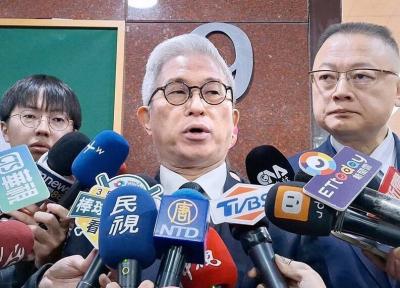A panel of defense experts on Thursday called for an Indo-Pacific initiative to combat disinformation, including efforts directed by Beijing.
Speaking at the Asia-Pacific Security Dialogue, a virtual conference hosted by the Ministry of Foreign Affairs, Lieutenant General Liu Te-chin (劉得金) said that disinformation is in China’s arsenal of “fourth-generation warfare” tools to use against Taiwan.
Fourth-generation warfare — a term used by US defense analysts in the 1980s — describes methods of conflict that blur the lines between war and politics.
China’s application of the idea includes demoralizing propaganda, Web-based disinformation, confrontations at sea and in the air, and manufactured disputes, said Liu, who is inspector-general of the Ministry of National Defense.
Steadily escalating “gray zone” conflict is aimed at diminishing trust in Taiwan’s government, he said.
Taiwan has improved its multiagency coordination, civil-military cooperation, information verification and partnerships with foreign states, he said.
The military has prepared mechanisms for rapid response and strategic communication, he added.
Taiwan has unique insight into China’s disinformation techniques that other countries lack, said Bonny Lin, director of the China Power Project at the Center for Strategic and International Studies.
Malicious influence campaigns are being directed against countries around the world, and governments could benefit from Taiwan’s wisdom and experience, Lin said.
The international community must join forces to honestly discuss the problem of disinformation and educate people to counter its effects, she said.
The fast-growing economies and fragile democracies of the Indo-Pacific region are vulnerable to online foreign meddling, said Jacob Wallis, head of information operations and disinformation at the Australian Strategic Policy Institute.
Countries in the region should create a forum or platform to defend their societies against targeted disinformation campaigns, Wallis said.
Such a forum should be open to experts working in academia and the private sector, not just government officials, he said, adding that it is needed to make governments more agile in their response to threats.
In related news, a military source yesterday said that two Chinese People’s Liberation Army vessels were identified off Taiwan’s east coast over the past two days.
A Chinese missile frigate was spotted 40 nautical miles (74km) off Hualien County at about 3am on Thursday, presumably heading south into the Bashi Channel, the source said.
Another frigate was detected about 24 hours later about 116 nautical miles off Green Island (綠島), the source added.
The second frigate sailed out of radar range at about noon yesterday, the source said, without saying which direction it was headed.
It was unclear why the ships were navigating so close to Taiwan, the source added.
Patrol ships from the 131st Fleet in Keelung were deployed on both occasions to monitor the frigates, the source said.
Ministry of National Defense spokesman Major General Shih Shun-wen (史順文) declined to comment on the report, saying only that the military constantly monitors military activities near Taiwan.
Additional reporting by CNA

Taiwan is to commence mass production of the Tien Kung (天弓, “Sky Bow”) III, IV and V missiles by the second quarter of this year if the legislature approves the government’s NT$1.25 trillion (US$39.78 billion) special defense budget, an official said yesterday. Commenting on condition of anonymity, a defense official with knowledge of the matter said that the advanced systems are expected to provide crucial capabilities against ballistic and cruise missiles for the proposed “T-Dome,” an advanced, multi-layered air defense network. The Tien Kung III is an air defense missile with a maximum interception altitude of 35km. The Tien Kung IV and V

The disruption of 941 flights in and out of Taiwan due to China’s large-scale military exercises was no accident, but rather the result of a “quasi-blockade” used to simulate creating the air and sea routes needed for an amphibious landing, a military expert said. The disruptions occurred on Tuesday and lasted about 10 hours as China conducted live-fire drills in the Taiwan Strait. The Civil Aviation Administration (CAA) said the exercises affected 857 international flights and 84 domestic flights, affecting more than 100,000 travelers. Su Tzu-yun (蘇紫雲), a research fellow at the government-sponsored Institute for National Defense and Security Research, said the air

A strong continental cold air mass is to bring pollutants to Taiwan from tomorrow, the Ministry of Environment said today, as it issued an “orange” air quality alert for most of the country. All of Taiwan except for Hualien and Taitung counties is to be under an “orange” air quality alert tomorrow, indicating air quality that is unhealthy for sensitive groups. In China, areas from Shandong to Shanghai have been enveloped in haze since Saturday, the ministry said in a news release. Yesterday, hourly concentrations of PM2.5 in these areas ranged from 65 to 160 micrograms per cubic meter (mg/m³), and pollutants were

Taiwan’s armed forces have established response protocols for a wide range of sudden contingencies, including the “Wan Chun Plan” to protect the head of state, the Ministry of Defense (MND) said today. After US President Donald Trump on Saturday launched a series of airstrikes in Venezuela and kidnapped Venezuelan President Nicolas Maduro, concerns have been raised as to whether China would launch a similar “decapitation strike” on Taiwan. The armed forces regularly coordinate with relevant agencies and practice drills to ensure preparedness for a wide range of scenarios, Vice Minister of National Defense Hsu Szu-chien (徐斯儉) told reporters before a